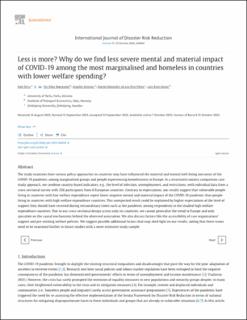| dc.contributor.author | Orru, Kati | |
| dc.contributor.author | Naevestad, Tor-Olav | |
| dc.contributor.author | Siimsen, Ingeliis | |
| dc.contributor.author | de los Rios Pérez, Daniel Alejandro | |
| dc.contributor.author | Egner, Lars Even | |
| dc.coverage.spatial | Estonia, Norway, Sweden | en_US |
| dc.date.accessioned | 2024-01-30T13:52:50Z | |
| dc.date.available | 2024-01-30T13:52:50Z | |
| dc.date.created | 2023-10-16T13:44:55Z | |
| dc.date.issued | 2023-10-21 | |
| dc.identifier.citation | International Journal of Disaster Risk Reduction. 2023, 97 (15 October 2023), 1-13. | en_US |
| dc.identifier.issn | 2212-4209 | |
| dc.identifier.uri | https://hdl.handle.net/11250/3114541 | |
| dc.description | Kati Orru, Tor-Olav Nævestad, Ingeliis Siimsen, Daniel Alejandro de Los Rios Pérez, Lars Even Egner, Less is more? Why do we find less severe mental and material impact of COVID-19 among the most marginalised and homeless in countries with lower welfare spending?, International Journal of Disaster Risk Reduction, Volume 97, 2023, 104034, ISSN 2212-4209, https://doi.org/10.1016/j.ijdrr.2023.104034. | en_US |
| dc.description.abstract | The study examines how various policy approaches in countries may have influenced the material and mental well-being outcomes of the COVID-19 pandemic among marginalised groups and people experiencing homelessness in Europe. In a structured country comparison case study approach, we combine country-based indicators, e.g., the level of infection, unemployment, and restrictions, with individual data from a cross-sectional survey with 226 participants from 6 European countries. Contrary to expectations, our results suggest that vulnerable people living in countries with low welfare expenditure report the lower negative mental and material impact of the COVID-19 pandemic than people living in countries with high welfare expenditure countries. This unexpected result could be explained by higher expectations of the level of support they should have received during extraordinary times such as the pandemic among respondents in the studied high welfare expenditure countries. Due to our cross-sectional design across only six countries, we cannot generalise the trend to Europe and only speculate on the causal mechanisms behind the observed association. We also discuss factors like care organisations' role and pre-existing welfare policies. We suggest possible additional factors that may shed light on our results, noting that these issues need to be examined further in future studies with a more extensive study sample. | en_US |
| dc.description.abstract | Less is more? Why do we find less severe mental and material impact of COVID-19 among the most marginalised and homeless in countries with lower welfare spending? | en_US |
| dc.language.iso | eng | en_US |
| dc.publisher | Elsevier Ltd | en_US |
| dc.rights | Navngivelse-Ikkekommersiell 4.0 Internasjonal | * |
| dc.rights.uri | http://creativecommons.org/licenses/by-nc/4.0/deed.no | * |
| dc.title | Less is more? Why do we find less severe mental and material impact of COVID-19 among the most marginalised and homeless in countries with lower welfare spending? | en_US |
| dc.title.alternative | Less is more? Why do we find less severe mental and material impact of COVID-19 among the most marginalised and homeless in countries with lower welfare spending? | en_US |
| dc.type | Journal article | en_US |
| dc.type | Peer reviewed | en_US |
| dc.rights.holder | © 2023 The Authors | en_US |
| dc.source.articlenumber | 104034 | en_US |
| dc.description.version | publishedVersion | en_US |
| cristin.ispublished | true | |
| cristin.fulltext | original | |
| cristin.qualitycode | 1 | |
| dc.identifier.doi | 10.1016/j.ijdrr.2023.104034 | |
| dc.identifier.cristin | 2185166 | |
| dc.source.journal | International Journal of Disaster Risk Reduction | en_US |
| dc.source.volume | 97 | en_US |
| dc.source.issue | 15 October 2023 | en_US |
| dc.source.pagenumber | 1-13 | en_US |
| dc.relation.project | EC/H2020/833496 | en_US |

